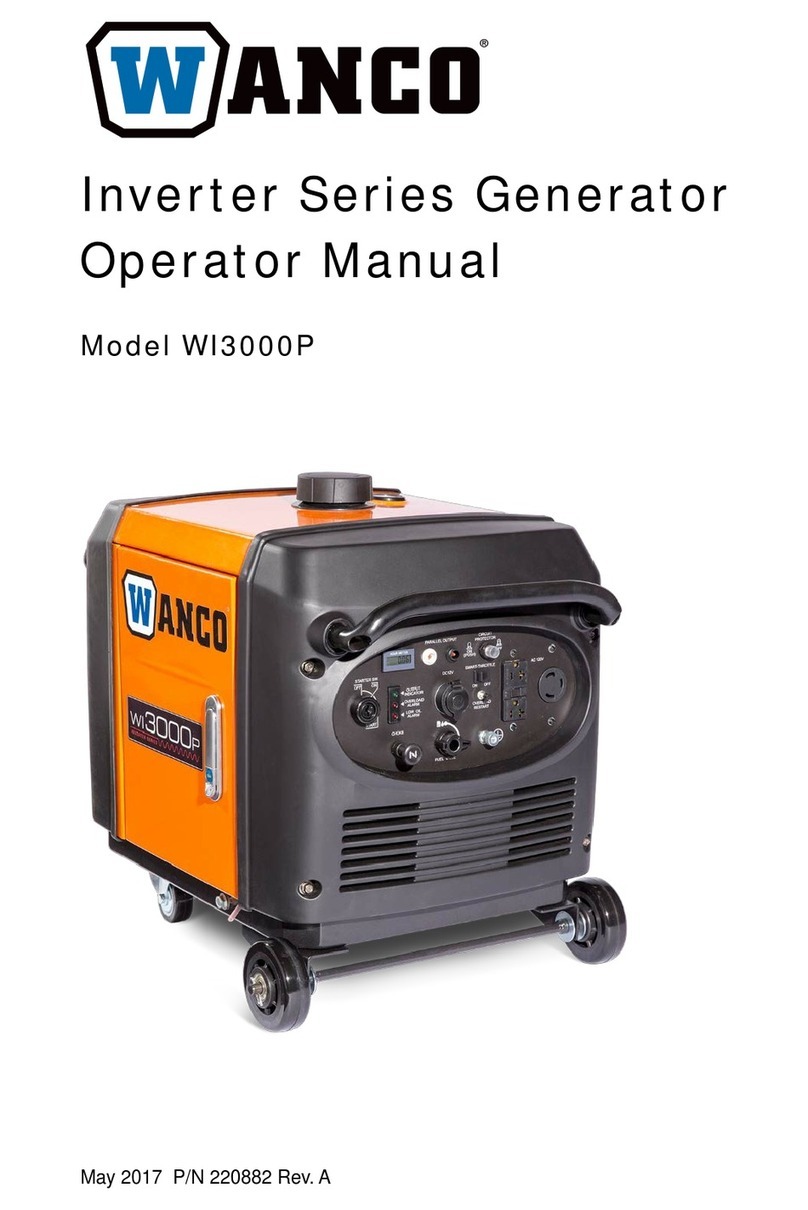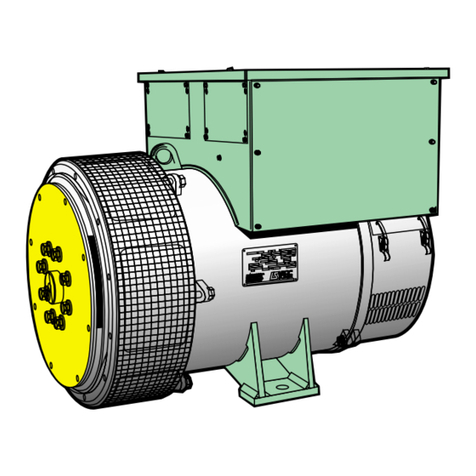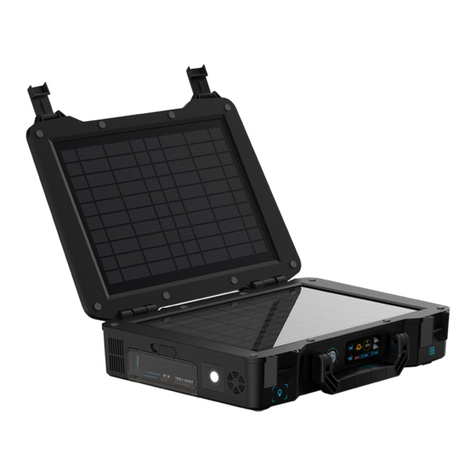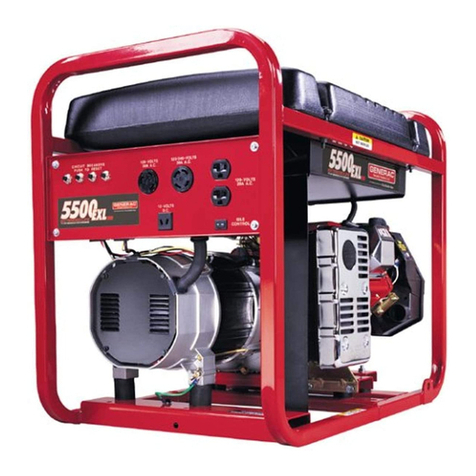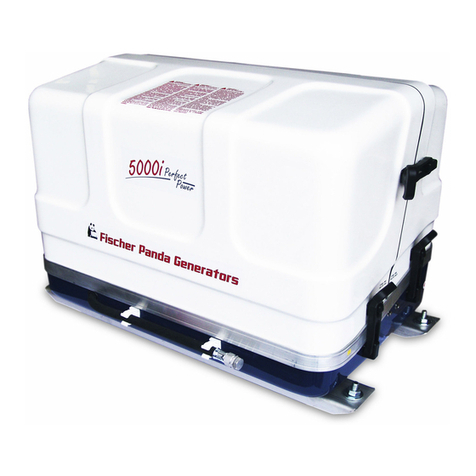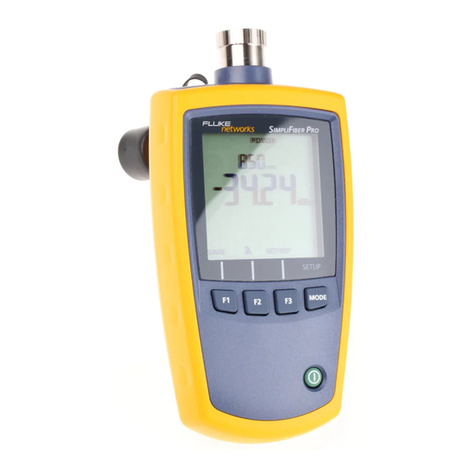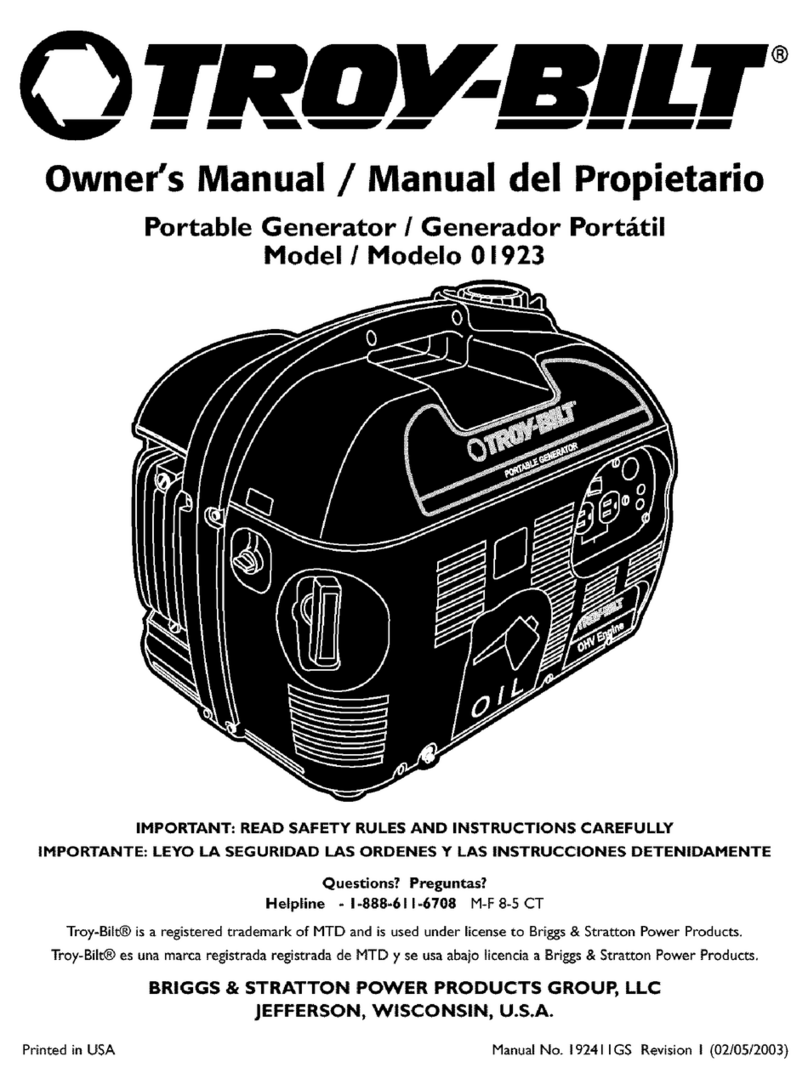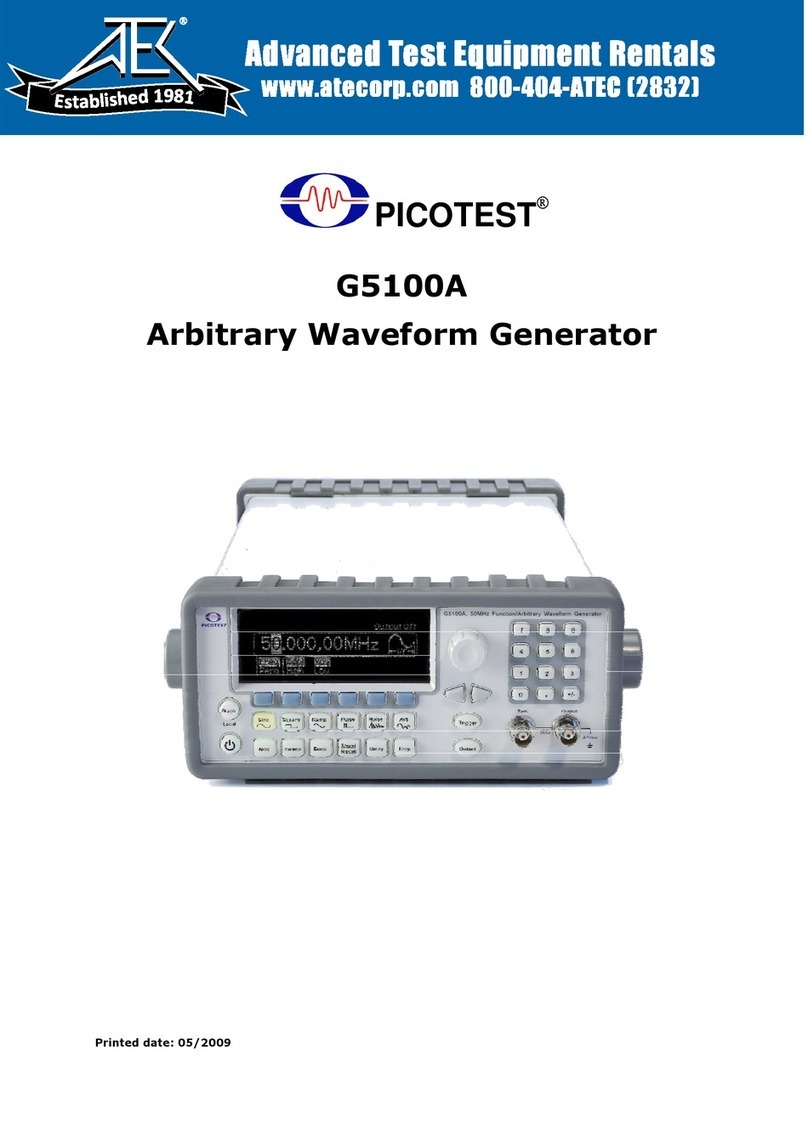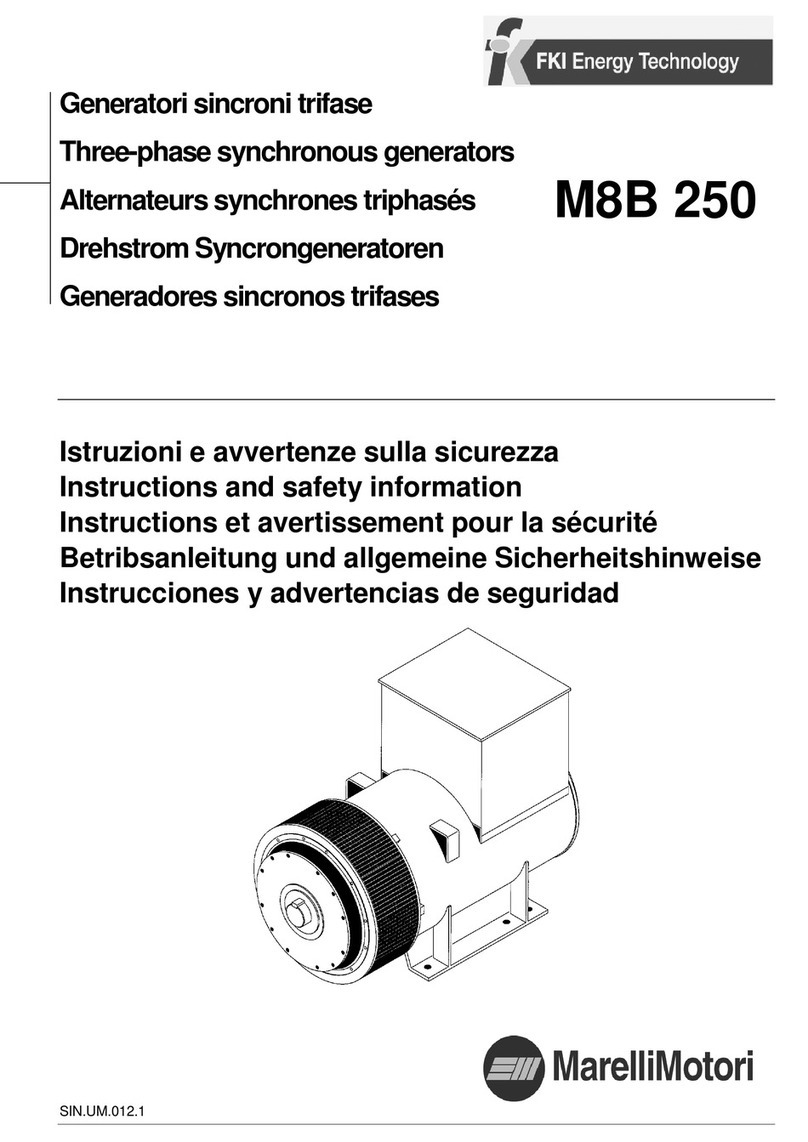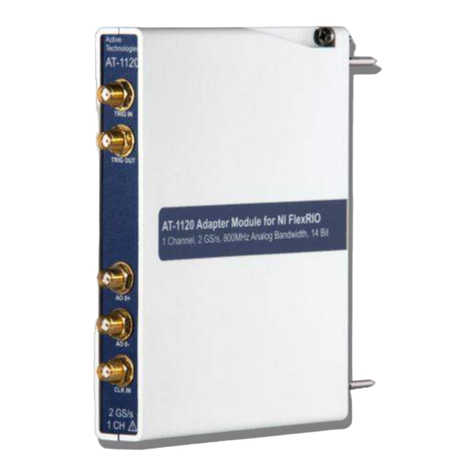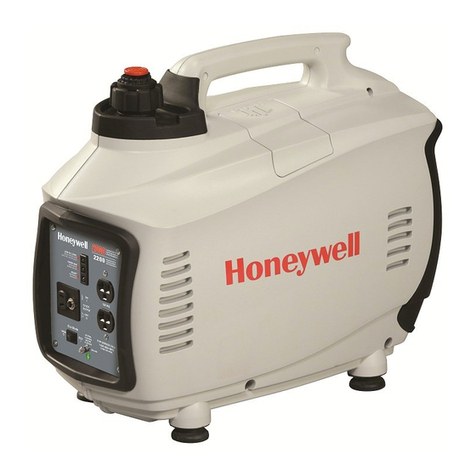GOAL ZERO Yeti 6000X User manual


Before using or storing, plug your Goal Zero Yeti into the wall until it is fully
charged. Keep your Goal Zero Yeti plugged in when not in use to ensure it is
always ready. This will NOT cause harm to your battery. For more tips and
tricks on keeping your battery healthy, see the BATTERIES 101 section.
CHARGEME NOW
3
2

Warranty
19
Français
22
Čeština
43
Español
64
Italiano
84
日本語
104
Getting Started
i. Get to Know Your Gear 2
ii. How itWorks
Charging Your Goal Zero Yeti 5
i. Charging from Solar
ii. Charging from the Wall
Using Your Goal Zero Yeti 7
i. How to use
ii. Best-Use Strategy
iii. Cold Weather Usage
iv. LCD Display
Storage and Downtime Maintenance 9
Technical Specifications 10
Frequently Asked Questions 12
Troubleshooting 16
Education 17
i. Batteries 101
ii. Solar 101
Table of Contents
Read all instructions and cautions carefully before use to avoid personal injury or
damage to the unit and any connected products
Observe all Input/Output connectors ratings: To avoid fire or electrical
shock hazard, observe all ratings on unit, and products you intend to use;
check manuals for more information.
Use in a ventilated area: Ensure proper ventilation while in use and do not
obstruct fan openings on unit. Inadequate ventilation may cause damage to
the unit. Do not stack anything on top of the unit in storage or in use.
Power supplies will get hot when in use: Keep your Yeti Power supply in
a dry, well ventilated area when in use. Do not keep the power supply under the
lid when in use.
DO NOT operate in wet conditions: In order to avoid short circuits or
electric shock do not allow unit to get wet. Let unit dry completely before
using.
Keep the unit clean and dry:Inspect the unit for dirt, dust, or moisture on
a regular basis.
Shock or Fire Hazard: This Yeti generates the same potentially lethal AC power
as a normal household wall outlet. Please use it carefully just like using a normal
AC outlet on the wall.
DO NOT insert foreign objects into outputs or ventilation holes.
DO NOT tamper with or attempt to replace your battery. For information about
a replacement battery contact the Goal Zero solutions center.
Any manipulation to the unit or its components will void all warranties.
IMPORTANT SAFETY INSTRUCTIONS
4

Get To Know Your Gear
8mm Input for Charging from Goal
Zero Solar Panels, or AC
Anderson Power Pole Input
for Charging from Goal
Zero Solar Panels, or AC
12VOutputs
USB 5V, up to 2.4A (12W)
USB-C 5-12V, 3A(18W)
USB-C Input/Output
Power Delivery
5-20V, up to 3A (60W)
Interactive Buttons
and LCD Screen AC Outputs
INPUT 12V UNIT LIGHT INFO 120VAC
USB-A 5V, 2.4AIN/OUT
60WPD 18WQC
2000W, 3500W SURGE
Buttons Under Lid:
Pressing the WiFi button will activate the Yeti’s WiFi for connection to a device. For information
on connecting your device to the Yeti, see the included Yeti App Start Up Guide. Also, holding
WiFi button switches between pairing and connecting modes.
Pressing and holding will perform a soft reset (does not perform a factory reset and does not reset
the watt hours). Must hold units button to reset watt hour counter.
Reset button
3
2
WiFi button
12Voutput8mm input

AC Plug
11 Hours
(600W Yeti X Power Supply)
12V Charger
55-110 Hours
(Sold separately)
600W of Solar
Input (Sold separately)
10 Hours
(Based off max input)
8W Lights
750+Hours 50” TV(4K, 60W)
100 Hours Fridge
100 Hours
+ MORE
CHARGE IT
WHAT IT
POWERS
How it Works
CHARGE ME NOW: Before using or storing, plug your Goal Zero Yeti into the wall until it
is fully charged. Keep your Goal Zero Yeti plugged in when not in use to ensure it is always
ready. This will NOT cause harm to your battery. For more tips and tricks on keeping your
battery healthy, see the BATTERIES 101 section.
When charging your Goal Zero Yeti, you will notice a battery segment blinking in the display. This
indicates the current charge status. Once your Goal Zero Yeti is fully charged, all battery segments
will be lit and remain solid. As long as there is more power going into the Goal Zero Yeti than is being
pulled from the output ports, the display will also indicate the time until fully charged. This is an
estimated time based on the power input and output numbers at that moment; it will gradually adjust
to a shorter or longer time as the average charge or discharge rates fluctuate.
Charging from the Wall
Using the included 600W AC Wall Charger, plug your Goal Zero Yeti into any wall outlet. You will
know the Goal ZeroYeti is charging when the blue LED light next to the INPUT port turns on, and
battery segments in the BATTERY DISPLAY are blinking. The Goal Zero Yeti is fully charged when all
battery segments stop blinking and remain solid. The Goal Zero Yeti should recharge from the wall
in about 11 hours.
1. The AC wall adapter comes in two pieces. Connect the two pieces by plugging the cable into
the box.
2. The 600W AC Wall Charger can be plugged into the the front of the Yeti.
3. Youcan only use one wall chargerat a time. If you want to charge your Yeti faster, call our
solutions center or look at our fast charge options on goalzero.com.
NOTE: To charge from your 12V output in your vehicle, use our 12V Car Charging Cable SKU
98079.
Charging Your Goal Zero Yeti
5
4

Charging from Solar
There are three different inputs you can use when charging your Goal Zero Yeti from solar, two of
which are located in the “INPUT” area on the left side of the Goal Zero Yeti faceplate and a third one
located inside the storage compartment under the top lid. One of the front ports and the port inside
the storage compartment are round 8mm ports designed to be used with Goal Zero Solar Panels or
wall charger. Each 8mm input port can handle up to 120W. The Anderson Power Pole port is designed
to be used with larger or higher power solar panels and can handle 600W of power, which is the total
capacity for power across all input ports.
1. Place your solar panel where it will get as much direct sunlight as possible.
2. Insert the blue-ringed solar panel plug into one of the INPUT ports, either on the front of the Goal
ZeroYetior in the storage compartment under the top lid. You will know the Goal ZeroYetiis charging
when the blue LED light next to the INPUT port lights up, and the battery segments in the BATTERY
DISPLAY are blinking. The Goal ZeroYetiis fully charged when all battery segments stop blinking and
remain solid.
3. You can also connect the Goal ZeroYetito solar panels using the Anderson Power- Pole port
and the appropriate adapter (if necessary), next to the 8mm charging port.
4. Youcan chainmultiple Goal ZeroSolarPanels togetherto reduce solarrecharge times. YourGoal
ZeroYetiis capable of takingin 120Wof inputthrough the 8mm portsand no morethan600Wof solar
through the APP port.
IMPORTANT NOTE: When solar recharging your Goal Zero Yeti Lithium, take note of the
voltages of the solar panels and do not exceed 50V.Individual solar panels, or solar panels
chained in series in excess of 50V cannot be used with the Goal Zero YetiLithium and can
cause serious damage to the unit. For help on chaining solar panels, call our Customer
Solutions Center at 888-794-6250.
How to use your Goal Zero Yeti:
1. Press the power button located above each port you will be using. **When not using
certain ports, make sure to turn them off to conserve power.
2. You’ll know the port is turned on when the white LED light on the button is
illuminated.
3. Plug in your gear for power anywhere life takes you.
4. If possible, keep your Goal Zero Yeti plugged into a power source when not in use.
5. You can charge your Goal Zero Yeti, and run your gear at the same time.
Best-Use Strategy:
WhencharginggearwithyourGoalZeroYeti,takenoteof the BATTERYDISPLAY.Ifyouplugin devices that have a
highpowerrequirement (a large refrigerator),the charge levelof your Goal ZeroYeti can dropveryquickly and
you may not get exactly 6000Whof capacity.Also,especially whenusingthe AC poweroutput,the GoalZero
Yetiwillbe convertingthe energy from the DC powerof the battery to theAC powerneededby yourdevice.
AlthoughyourGoalZeroYetihas
a highly efficient inverter, there is still some energy lost in theconversion and you will notget the full rated
capacity of the battery. If you’re experiencing shorter runtimes, you may want to check the device’s power
requirements,seeTROUBLESHOOTINGforhelp.
Using your Goal Zero Yeti
NOTE:If you are inputting from solar panels into multiple portsyou can onlycombine inputs if the panels
beingusedare the samevoltage. Panels thatoutput different voltages willnot be ableto combine through
different ports.If you areusingpanelswithdifferent voltages intotwoor moreof the inputports,the Yeti
willselectthe singlehighestsolarinput available. Also,solarandAC inputs will not be ableto be
combined. Ifyou are inputtingfrom botha solarpaneland awall outlettheYetiwillselect the higherof the
twoinputs.
7
6

Cold Weather Usage:
Cold temperatures (below freezing) can impact the Goal Zero Yeti’s battery capacity. If you’ll be out
living off-grid in sub-zero conditions, we recommend keeping your Goal Zero Yeti in an insulated
cooler, connected to a power source (solar panels), and charging your gear. The natural heat
generated by the Goal Zero Yeti contained in an insulated cooler will keep battery capacity at its
highest. The Yeti will not allow charging below freezing for safety reasons. The unit will warn show a
warning on the LCD as you approach
this temperature
LCD Display
The built-in LCD display indicates four
important things:
1. INPUTshows the amount of power (watts) going into the Goal ZeroYetiwhile charging. If charging
from solar,you’ll see the watts change as you reposition the panels into/out of the sunlight.
2. OUTPUTshows the amount of power (watts) your devices are using while plugged into the
Goal ZeroYeti.
3. TIME TO EMPTY/FULL shows the amount of time before your Goal ZeroYeti is completely
charged or empty, depending on if the net amount of power going into the Goal ZeroYeti is
positive or negative.
4. BATTERYLEVEL shows 5 segments, approximating 20% -40% -60% -80%
-100% capacity. As you use your Goal ZeroYeti, segments will disappear from the display, indicating
the remaining charge. When charging your Goal ZeroYeti you will notice a battery segment blinking.
This indicates the current charge status. Once your Goal ZeroYeti is fully charged, all battery segments
will be lit and remain solid. As long as there is more power going into the Goal ZeroYeti than is being
pulled from the output ports, the display will also indicate the ttime until fully charged.This is an
estimated time based on the power input and output numbers at that time; it will adjust to a shorter
or longer time if the charge or discharge rates fluctuate. Note that when you first plug in a
Storage and Downtime Maintenance
Having your Goal Zero Yeti connected to a power source, like a solar panel or wall plug, between
adventures or while in storage keeps its battery healthy and topped off. This prolongs battery life
and will ensure your Goal Zero Yeti is charged and ready to go all day, every day.
If you can’t keep your Goal Zero Yeti plugged into a power source during storage, fully-charge
your Goal Zero Yeti every 3 months and store it in a cool, dry place. If the Yeti has not been used
for several months, it may require several charge cycles to restore accurate results on the battery
percent and time remaining values on the screen. Failure to maintain your Goal Zero Yeti by
following these steps can result in battery damage which will void the product warranty.
9
8
power source,whether it’s a solar panel or a wall charger,the Yeti may take a minute to detect and
adjust its charge circuitry before it starts drawing power from the source.
5. The WiFi symbol indicates the Yeti’sWiFi is turned on. If flashing, the Yetiis ready to connect to a
device.
Front Buttons:
Pressing the LIGHT button will turn the display backlight on and off.
Pressing the UNIT button will scroll through different output and power consumption settings.
Hold units + info to perform factory reset. this deletes wifi information and configurations. Hold
units to reset watt hour counter.
Pressing the INFO button will alternate the screen between showing the detailed battery state of
charge percentage and the Time to Empty/Full.

Technical Specifications
Charge times
Maximum input (standard) 11 hrs
Goal Zero Ranger 300 24-48 hrs
Goal Zero Boulder (3X) 200 Briefcase 12-14 hrs
Goal Zero Boulder (6X) 200 Briefcase 11-12 hrs
Battery:
Cell Chemistry Li-ion NMC
Pack Capacity 6010Wh (10.8V, 557Ah)
Single Cell Equivalent Capacity 1668Ah @ 3.6V
Lifecycles 500 Cycles to 80% capacity (Discharge rate: 1C, Full
charge/discharge, Temp: 25C)
Shelf-life Charge every 3-6 months
Management System MPPT charge controller
Ports:
USB-A Port (output) 5V, up to 2.4A (12W max), regulated
USB-C Port (output) 5 - 12V, up to 3.0A (18W max), regulated
USB-PD Port (output) 5 - 20V, up to 3.0A (60W max), regulated
6mm Port (output, 6mm) 12V, up to 10A (120W max), regulated
12V Car Port (output) 12V, up to 13A (160W max), regulated
12V Power Pole port (output) 12V, up to 30A (360W max), regulated
120V AC Inverter (output, pure sine wave) 120VAC 60Hz, 16.5A (2000W, 3500W surge)
230V AC Inverter (output, pure sine wave) 230VAC 50Hz, 8.5A (2000W, 3500W surge)
UNIVERSAL OR AUSTRALIA (TYPE 1) AC PLUGS
Charging Port (input, 8mm) 14-50V, up to 10A (120W max)
Power Pole Charging Port (input) 14-50V, up to 50A (600W max)
Expansion Module port Covered port under the lid. To be used with Goal Zero
expansion modules only.
Technical Specifications
WiFi:
RF Certification FCC/CE/IC/TELEC/KCC/SRRC/NCC
Protocols 802.11 b/g/n (802.11n up to 150 Mbps)
Frequency Range 2.4~2.5 GHz
Bluetooth:
Protocols Bluetooth Low Energy
General:
Weight (Yeti only) 97.35 lbs (44.16 kg)
Weight (cart only) 106.1 lbs (48.11 kg)
Dimensions (Yeti only) 15.25 x 10.23 x 17 in (38.74 x 25.98 x 43.2 cm)
Dimensions (Yeti & Roll Cart) 20.5 x 14.6 x 19.01 in (51.99 x 36.98 x 48.28 cm)
Operating Usage Temp. 32-104 F(0-40 C)
Certs
Warranty 24 months
11
10

Frequently Asked Questions
My yeti is not responding or is exhibiting odd behavior what should I do?
Try resetting the unit by holding the Units and Info button for 3 seconds to reset your Yeti. Check
your Yeti to see if the issue is resolved after the reset.
My new Yeti does not initially charge to 100%, it only charges to 95% what’s going
on?
Cycle the battery a few times and the issue should resolve itself as the yeti dials in its charge
parameters.
Are there faster ways to recharge my Yeti?
Yes, check out our full list of charging options at Goalzero.com. Here we have options for fast
charging as well as vehicle integration.
There is a new version of Firmware available and I want to update my Yeti how do I
do this?
Download the Goal Zero app from your favorite app store and follow the instructions there for
an update to your Yeti.
During the update process, my Yeti is stuck in a loop and keeps trying to update
over and over unsuccessfully. How do I fix this?
Try resetting the Yeti following the instructions from Q1 and restart the update process.
This should fix the issue.
What does the snowflake icon and the thermometer icon mean?
If your yeti displays the thermometer icon and a warning of HOT or COLD, this means you are
either approaching or have exceeded the temperature thresholds of the
Yeti. A warning of “cold” means you will need to warm the yeti in order to resume full
functionality while “hot” means you need to cool the unit.
13
12
have my Yeti connected to a charger but it is at 98% and not charging, what is going
on?
In order to get the most life out of your battery we make sure to not stress the battery pack at
the full state of charge. The battery will charge to 100% and then stop, self- discharge over time
to 98% before the charge will engage again. If you are wanting to make sure your Yeti is
completely topped off for upcoming use, unplugging and then re-plugging in your input cable
should reengage the input and start the charge again
My old Yeti accessory or charger is not working with my new Yeti X, should it be
working?
Some of the smaller power supplies and legacy chargers will not work with the new Yeti X. For a
full list of compatible charger and accessories for your product please vist
www.goalzero.com/accessories.
Can I use my 3rd party panels with my Yeti
Yes, you can, so long as you stay under 50V. If using multiple 3rd party panels, be careful! Chaining
3rd party panels together can be dangerous if done in the wrong way. For more information
contact our customer service team via telephone at (888) 794- 6250, or via email at
support@goalzero.com.
Can I chain multiple Goal Zero panels into a Yeti X?
Yes, our panels are designed to be safely chained together out of the box and eliminate the risks
associated with 3rd party panels.
My yeti is not responding or is exhibiting odd behavior what should I do?
Your Goal Zero Yeti uses custom designed Lithium Ion. Here are some basic facts about Lithium Ion
batteries:
1. . Lithium Ion batteries can store and release a lot of energy in a short period of time. The
batteries in your Goal ZeroYetiare in a protective enclosure with a sophisticated battery
management and protection system controlling its terminals to the outside world.
2. .It is critical that your battery does not get wet as moisture and watercan get into the battery
cells behind the protection circuitry and bypass that protection.

15
14
How do I know if my Goal Zero Yeti is charged?
To check the charge level of your Goal Zero Yeti, refer to the Battery Display. When lit up, you’ll see a
battery outline with 5 segments, indicating the current charge level. It is OK to use your Goal Zero Yeti
even when it’s not fully charged.
How do I know if my device will work with the Goal Zero Yeti ?
First, you’ll need to determine the amount of power your device requires. This may require some
research on your end, a good internet search or examining the user guide for your device should
suffice.
Second, you will need to check the capacity for the individual output ports. For example, the Goal Zero
Yeti’sAC port is powered by an inverter that allows for 2000W of power. This means if your device is
pulling more than 2000W for an extended period of time, the Goal Zero Yeti’s inverter will shut off.
Another number to watch for is the surge rating of your device as compared to that of the port. The
Goal Zero Yetiinverter has an advanced surge management system that will maximize its compatibility
with various devices, but there will still be items that will surge at a higher rate, and for a longer time,
than the Goal ZeroYetican manage, in which case the port will turn itself off.
Finally, once you know your device is compatible, you’ll want to determine how long you’ll be able to
power your gear from the Goal Zero Yeti.Here’s a quick and dirty lesson in power.
All GOAL ZERO Power Banks and Portable Power Stations have a number in their name, ex.
Sherpa100AC, Goal Zero Yeti 6000X. These numbers refer to the Watt Hours (Wh), or the amount of
energy that can be stored in each recharger, and how you’ll know if your
gear is compatible with each recharger. For example, a 200Wh power station should run a 100W light
for 2 hours (200/100=2). If your gear falls within the 6000Wh capacity of the Goal Zero Yeti, you’ll want
to check the restrictions on each of the output ports.
Another factor in the math is how much power is being converted going from the Goal Zero Yeti
battery to the device you are powering/charging. In some situations, like when running a 12V
device, such as the LAL 350, directly off the 12V port, there will minimal conversion and thus very
little additional losses. In using the USB ports to
charge a phone, you add a layer of conversion (12V battery in the Goal Zero Yeti is being converted to
a5V USB output), which introduces around 10% of losses. When using the inverter, there are two
layers of conversion (12V to high voltage, DC to AC). The least efficient way of using the battery in the
Goal Zero Yeti is to use an AC-DC adapter off the AC ports, as is the case if you use a phone wall
charger to charge your phone, as it adds yet another layer of conversion in the wall adapter.
So when you’re deciding on what to power from your new GOAL ZERO recharger, do some
research into your device’s watt consumption. For more quick tips and learning tools, check out
www.GoalZero.com/learn.html

If your devices are not recharging from your Goal Zero Yeti, follow these steps:
1. Ensure the Output Port has been turned on. The white LED light on the power button should be
lit up.
a. If any of the lights have turned red, this indicates a trip. Push the button again to reset it. The light
will turn white when it is successfully reset.
2. Check the Battery Display. If it is at 20% or below, charge your Goal Zero Yeti.
3. Check the LCD Display for warning icons:
OVERLOAD: Powerdraw exceeds port’s maximum allowance. Indicated by red light in the
port’s button.
4. Verify your device is suitable for use with the Goal Zero Yeti:
a. All of the Goal ZeroYeti output ports have their own max power capacity. Check the Goal Zero
Yeti’sTechSpecs to ensure your device is compatible.
5. If you are still experiencing trouble with your Goal Zero Yeti, please call our Customer Solutions
Center at 1-888-794-6250 or by email at support@goalzero.com.
Ifyou are having trouble with WiFi connection:
1. Press and hold the WiFi button for approximately 3 seconds to force the Yeti into
connection mode. The WiFi symbol on the screen will begin to flash.
2. Reconnect your device to your Yeti following the instructions in the Goal Zero Yeti App.
NOTE: If none of these solutions resolve your issue try resetting the unit by holding the Units and
Info button for 3 seconds to reset your Yeti. Check your Yeti to see if the issue is resolved after the
reset.
Troubleshooting
Temperature warning.
Allow unit to cool.
Battery requires attention.
Contact customer support. 1-
888-794-6250
Education
BATTERIES 101:GOAL ZERO utilizes the latest and greatest in battery technology to accompany
you on all life’s adventures. From the versatile and lightweight Lithuim Ion, to the robust and
powerful Lead Acid, we’ve compiled some helpful tips to keep your GOAL ZERO batteries working
their best.
i. Batteries need exercise.
The best thing for any battery is to use it.Don’t leave the battery sitting without being charged for
extended periods of time. If you will be storing the Goal Zero Yeti without a charger, make sure it’s
fully charged before you put it away.
ii.The “Battery Memory” myth.
Thanks to old Nickel-Cadmium (NiCd) batteries, there’s a myth running around that you should completely
drain your batteries before plugging them in for a recharge, called “deep cycling”. Although true with NiCd
batteries, the typical batteries you’ll find in most of your gear today, including the advanced lithium and
lead-acid batteries used in your GOAL ZERO rechargers, require no such draining. In fact, you should avoid
deep cycling your batteries –it does more harm than good in most cases.
iii.The “Stadium Effect”.
The stadium effect occurs when recharging your batteries. You’ll notice your battery quickly filling up in the
beginning, then slowing down noticeably when trying to charge up the last several percentages.Think of
how quickly a stadium fills up when the doors first open –there are hundreds of open seats so it’s easy to
find the one you want. Eventually there are only
a few open seats here and there and people have to maneuver around to find the spot they want and
filling those seats takes longer. The same theory applies to recharging batteries. It’s easy for energy to
flow in and take up empty space in the beginning, and as time goes on and there is less space available, it
takes longer for the energy to fill in the holes.
iv. Read the manual.
Yeah, it might be along read, but the manual is the best place to find the dos and don’ts for the battery
in your specific device. Reading your manual will ensure you’re taking steps to keep your batteries happy
and healthy.
17
16

SOLAR 101: GOAL ZERO makes it easy to recharge your gear from the sun –we didn’t invent
solar power, we perfected it. Some things to keep in mind when recharging your gear with solar
power:
i.Solar panels don’t store power from the sun, they collect it.
We teach you to COLLECT–STORE –USE, which is the best way to utilize solar power to rechargeyour
gear.COLLECTthe sun’s energy with a solar panel. STORE the power in a recharger.USE the recharger to
poweryour gear,day or night. If you’re really a diehard, you can plug your gear directly into the junction
box located on the back of our NOMAD Solar Panels to recharge from the sun.
ii.Not all solar charge times are created equal.
Most solar panel manufacturers calculate their recharge times with the following equation: Device Watt
Hours/Solar Panel Watts = Solar Recharge Times. So theoretically, a 13 watt solar panel would recharge
a50 watt-hour recharger in 3.84 hours (50/13 = 3.84) –and this is the number you could find in
marketing material for a solar panel. However, in order to standardize results across all manufacturers,
these tests are completed in laboratory
settings. The truth is, on a good, sunny day,you’ll receive about 50-75% of your solar panel’s rated
wattage, and this is how the engineers at GOAL ZERO calculate the solar recharge times you see on our
packaging.
iii. Solar works, even in overcast conditions.
Solar panels utilize IR, UV, and visible rays from the sun that can penetrate through clouds. Although the
efficiency of the solar panel will decrease in cloudy conditions, you’ll still be collecting valuable power
from the sun.
iv.Keep away from shade and windows.
Although you should seek out the shade on sunny days, your solar panels will collect more power
when fully exposed to the sunlight. Windows also have a habit of decreasing efficiency. So keep those
panels outside and in the bright sunlight.
v.Proper alignment works wonders.
Keeping your solar panel angled toward the sun can dramatically increase solar efficiency. Set it up and
let Mother Nature do the rest.
Warranty & Contact
LIMITED WARRANTY
This LIMITED WARRANTYfrom GOAL ZERO LLC (“GOAL ZERO”) warrants to the original consumer purchaser that this
GOAL ZERO product will be free from defects in workmanship and material under normal consumer use during the
applicable warranty period identified in Paragraph 2, below, subject to the exclusions set forth in Paragraph 5,
below. The foregoing provisions state GOAL ZERO’s entire
liability, and your exclusive remedy, for any breach of warranty, express or implied. GOAL ZERO will not assume, nor
authorize any person to assume for it, any other liability in connection with the sales of GOAL ZEROproducts.
19
18
WARRANTY PERIOD
The warranty period for GOAL ZERO lead acid batteries(whether purchased on a stand-alone basis or as part of another
product) is One Hundred and Eighty (180) days.
The warranty period for GOAL ZERO lithium battery based Yeti products and Boulder solar panels is two
(2) years.
The warranty period for all other GOAL ZERO products and components is one (1) year from the date of original
purchase by the original consumer
A sales receipt from the original consumer purchase, or other reasonable documentary proof, is required in order to
establish the start of the warranty period. If you completed the online GOAL ZERO Product Registration Form within
thirty (30) days after purchasing your product, that registration can also establish the start date of the warranty period
(but warranty coverage is not conditioned upon such registration).
REMEDY
GOAL ZERO will, at its option, (1) repair the product at no charge, using new or refurbished replacement parts, or (2)
exchange the product with a product that is new or which has been manufactured from new or serviceable used parts
and is at least functionally equivalent to the original product. A replacement product/part assumes the remaining
warranty of the original product or ninety (90) days from the date of replacement or repair, whichever provides longer
coverage for you. When a product or part is exchanged, any replacement item becomes your property and the replaced
item becomes GOAL ZERO’s property.
LIMITED TO ORIGINAL CONSUMER BUYER
This warranty is not transferable to any subsequent owner of a GOAL ZERO product.

EXCLUSIONS
This LimitedWarranty applies only to hardware products manufactured by or for GOAL ZERO that can be identified by
the “GOAL ZERO” trademark, trade name, or logo affixed to them. The Limited Warranty does not apply to any non-
GOAL ZERO products, even if packaged or soldwith GOAL ZERO products. Non-GOAL ZERO manufacturers, or suppliers
may provide their own warranties. For consumers outside of the contiguous US 48 states, a one (1) year warranty period
is enforced for lithium power stations and Boulder solar panels. Claims on lithium power stations and Boulder panels
from consumers outside of the contiguous 48 states after the one (1) year warranty period will be handled on a case by
case basis, in compliance with local regulatory standards.
This warranty does not apply to: (i) to damage caused by accident, abuse, misuse, misapplication, or non-GOAL ZERO
products; (ii) to damage caused by service performed by anyone other than GOAL ZERO; (iii) to a product or a part
that has been modified without the written permission of GOAL ZERO;
(iv) to a product where any GOAL ZERO serial number has been removed or defaced, or (v) to any product purchased
through an online auction house. This limited warranty does not apply to any battery cell or product containing a
battery cell unless the battery cell has been fully charged byyou withinseven (7) days after your purchase of the
product and at least once every 6 months thereafter.
THIS WARRANTYAND REMEDIES SET FORTH ABOVE ARE EXCLUSIVE AND IN LIEU OF ALL OTHER WARRANTIES,
REMEDIES AND CONDITIONS,WHETHER ORAL OR WRITTEN, EXPRESS OR
IMPLIED. GOAL ZERO SPECIFICALLYDISCLAIMS ANYAND ALL IMPLIED WARRANTIES, INCLUDING, WITHOUTLIMITATION,
WARRANTIES OF MERCHANTABILITYAND FITNESS FOR A PARTICULAR PURPOSE. IF GOAL ZERO CANNOTLAWFULLY
DISCLAIM IMPLIED WARRANTIES UNDER THIS LIMITED WARRANTY, ALL SUCH WARRANTIES, INCLUDING WARRANTIES OF
MERCHANTABILITY AND FITNESS FOR A PARTICULAR PURPOSE ARE LIMITED IN DURATION TO THE DURATION OF
THIS WARRANTY. No GOAL ZERO reseller, agent, or employee is authorized to make any modification, extension, or
addition to this warranty. IN NO EVENTWILL GOAL ZERO BE LIABLEFOR ANYDIRECT, SPECIAL, CONSEQUENTIALOR
INCIDENTALDAMAGES ARISING FROM ANYUSE OR MALFUNCTION OF ANYGOAL ZERO PRODUCT, OR FROM ANY BREACH
OF WARRANTY, INCLUDING DAMAGE
TO OTHER DEVICES. IN NO EVENTWILL GOAL ZERO’S LIABILITYFOR ANY CLAIM, WHETHER IN CONTRACT, WARRANTY,
TORT (INCLUDING NEGLIGENCE AND STRICT LIABILITY), OR UNDER ANY OTHER THEORY OF LIABILITY, EXCEED THE
AMOUNTPAID BYYOU FOR THE GOAL ZERO PRODUCT.
Some states do not allow limitations on how long an implied warranty lasts, so the above limitation may not apply to
you. This warranty givesyou specific legal rights, and you may also have other rights which vary from state to state.
OBTAINING WARRANTY SERVICE
To obtain warranty service, you must contact our customer service team via telephone at (888) 794- 6250, or via email
at support@goalzero.com. If our customer service team determines that this is a warranty matter, they will give you a
Return Material Authorization (“RMA”) number. Youmust properly package the product, clearly marking the RMA
number on the package and including proof of your purchase date with the product. Youmust then send the product by
mail or courier, with shipping costs paid by you, to GOAL ZERO at 675 West 14600 South, Bluffdale, Utah, USA 84065. We
will process your return and send your repaired or replacement product to you at our expense for product being
shipped to locations in North America. For product purchased or being shipped outside of North America, please
contact the local distributor from whom you purchased the product, or email support@goalzero. com to obtain further
distributor information.
2 YEARWARRANTY
21
20

Veuillez lire toutes les consignes et mises en garde avec soin avant toute utilisation
pour éviter d'éventuelles blessures corporelles ou des dommages sérieux à l'appareil
ou tout autre appareil connecté
Veuillez respecter toutes les puissances nominales des connecteurs
d'Entrée/Sortie :Pour éviter tout risque d'incendie ou d'électrocution, veuillez observer
toutes les indications de puissance nominale sur l'unité et celles des produits que vous
souhaitez utiliser ;Veuillez vérifier leurs manuels respectifs pour plus d'informations.
Àutiliser dans un espace bien ventilé :Assurez une ventilation adéquate
pendant son utilisation et n'obstruez jamais les ouvertures du ventilateur de cet
appareil. Une ventilation inadéquate peut endommager l'appareil. Ne pas empiler
quoi que ce soit sur l'appareil lors de son stockage ou de son utilisation.
Les alimentations électriques chauffent lorsqu'elles sont utilisées :veuillez
garder votre bloc d'alimentation Yeti dans un endroit sec et bien ventilé lorsqu'il
est utilisé.Ne pas garder l'alimentation électrique sous le couvercle pendant
l'utilisation.
NE PAS le faire fonctionner dans des conditions humides : Afin d'éviter les
courts-circuits ou les chocs électriques, ne permettez pas àl'appareil de devenir
mouillé. Laissez l'appareil sécher complètement avant de l'utiliser ànouveau.
CONSIGNES DE SÉCURITÉ IMPORTANTES
Avant l'utilisation ou le stockage, branchez votre Goal Zero Yeti au mur jusqu'à la
charge complète. Maintenez votre Goal Zero Yeti branché lorsqu'il n'est pas en cours
d'utilisation pour vous assurer qu'il est toujours prêt.
Cette action n’abîmera PAS votre batterie. Pour plus de trucs et astuces pour
garder votre batterie en bon état, rendez-vous dans la section PRINCIPES DE BASE
SUR LES BATTERIES.
RECHARGEZ-MOI MAINTENANT Gardez l'appareil propre et sec : Inspectez régulièrement l'appareil pour la saleté, la
poussière ou l'humidité.
Risque dechoc oud'incendie :ce Yetigénère la même puissance électrique potentiellement mortelle
qu'une prise murale domestique normale. Utilisez-le avec autant de précaution que lors de
l'utilisation d'une prise secteur murale.
NE PAS insérer d'objets étrangers dans les sorties électriques ou les ouvertures de
ventilation.
NE PAS trafiquer la batterie ou essayer de la remplacer. Pour plus d'informations àpropos du
remplacement de la batterie, contactez le centre de solution Goal Zero.
Toute manipulation sur l'unité ou ses composants annulera toutes les garanties.
23
22

Apprendre à Connaître Votre Équipement
Entrée de 8mm pour charger à
partir des Panneaux Solaires de
Goal Zero ou de CA
Entrée pour les connecteurs
Anderson Power Pole
pour charger àpartir des
panneaux solaires de Goal
Zero, ou de CA
Sorties de
12V
USB 5V, jusqu'à 2.4A (12W)
USB-C 5-12V, 3A(18W)
Entrée/sortie de
distribution d'énergie pour
ports USB-C
5-20V, jusqu'à 3A (60W)
Boutons Interactifs
et écran LCD
sorties CA
ENTRÉE 12V MODULE LUMIERE INFO 120VCA
USB-A 5V, 2.4A
ENTRÉE/SORTIE
60WPD 18WQC
2000W, 3500W À
PLEINE TENSION
Boutons sous le couvercle :
Appuyer sur le bouton WiFi activera le Wi-Fi du Yeti pour le connecter àun périphérique. Pour plus
d'informations sur la connexion de votre appareil au Yeti, reportez-vous au guide inclus de
l'application Yeti. De plus, le fait de maintenir le bouton WiFi appuyé bascule entre les modes
d'appairage et de connexion.
Une pression prolongée maintiendra une réinitialisation logicielle (n'effectue pas une
réinitialisation d'usine et ne réinitialise pas les wattheures). Le bouton des unités doit être
maintenu pour réinitialiser le compteur de wattheures.
Bouton de
réinitialisation
25
24
Bouton WiFi
Sortie de 12VEntrée de 8mm

Prise de CA Chargeur 12 V
11 heures 55-110 heures
(Alimentation Yeti X 600 W) (Vendu séparément)
600W Énergie solaire
(Vendu séparément)
10 heures
(basé sur une tension d'entrée
maximale)
8W Lumières
750+heures TV50" (4k, 60W)
100+heures
Réfrigérateur
100+heures
+ PLUS
LE RECHARGER
CE QU'IL ALIMENTE
Comment ça marche
CHARGEZ-MOI MAINTENANT : avant de l'utiliser ou de le stocker, branchez votre Goal
Zero Yeti sur une prise murale jusqu'à ce qu'il soit complètement chargé. Maintenez votre
Goal Zero Yeti branché lorsqu'il n'est pas en cours d'utilisation pour vous assurer qu'il est
toujours prêt. Cette action n’abîmera PAS votre batterie. Pour plus de trucs et astuces pour
garder votre batterie en bon état, rendez-vous dans la section PRINCIPES DE BASE SUR
LES BATTERIES.
Lorsque vous rechargez votre Goal Zero Yeti, vous remarquerez un segment de la batterie qui
clignotera à l'écran. Cela indique l'état actuel de charge. Une fois que votre Goal Zero Yeti est
complètement rechargé, tous les segments de la batterie s'allumeront et resteront allumés. Tant
qu'il y aura plus de courant entrant dans la batterie Goal Zero Yeti que de courant tiré des ports de
sortie, l'affichage indiquera également un temps estimé jusqu'à ce qu'il soit complètement rechargé. Il
s'agit d'une durée estimée basée sur le nombre d'entrées et de sorties d'alimentation àce moment-là ;
Cette durée s'ajustera àun temps plus court ou plus long lorsque les taux de charge ou de décharge
fluctuent.
Charge àpartir d'une prise murale
En utilisant le chargeur mural de 600W CA inclus, branchez votre Goal Zero Yeti dans n'importe
quelle prise murale. Vous saurez quand le Goal Zero Yeti sera en charge lorsque le voyant bleu à
côté du port d'entrée s'allumera et que les segments de la batterie dans l'AFFICHAGE DE LA
BATTERIE clignoteront. Le Goal Zero Yeti est complètement chargé lorsque tous les segments de la
batterie cessent de clignoter et restent éclairés en continu. Le Goal Zero Yeti devrait se recharger
àpartir d'une prise mural11 heures environ.
Charger votre Goal Zero Yeti
27
26

29
28
1. L'adaptateur mural CA est livré en deux parties. Connectez les deux pièces en branchant
le câble dans le boîtier.
2. Le chargeur mural CA de 600W peut être branché dans l'avant du Yetiou sous le couvercle.
3. Vous pouvez uniquement utiliser un chargeur mural àla fois. Si vous souhaitez rechargervotre
Yeti plus rapidement, contactez notre centre de solutions ou consultez nos options de charge
rapide sur goalzero.com.
REMARQUE :pour recharger àpartir d’une sortie de 12V dans votre véhicule, utilisez notre câble de
recharge 12V pour voiture, SKU 98079.
Charge àpartir d'une source solaire
Il y a trois entrées différentes que vous pouvez employer quand vous chargez votre Goal Zero Yeti
par le biais de l'énergie solaire, dont deux sont situées dans la zone des entrées marquées « INPUT
»sur le côté gauche de la face avant du Yeti et une troisième située à l'intérieur du compartiment
de rangement sous le couvercle du haut. L'un des ports avant et le port à l'intérieur du
compartiment de rangement sont des ports ronds de 8mm conçus pour être utilisés avec les
panneaux solaires ou le chargeur mural de Goal Zero. Chaque port d'entrée de 8mm peut supporter
jusqu'à 120W. Le port pour les connecteurs Anderson Power Pole est conçu pour être utilisé avec
des panneaux solaires de plus ou de plus puissant et peut supporter jusqu'à 600W de courant, qui
est la capacité totale de charge qui peut être supportée à travers tous les ports d'entrée.
REMARQUE IMPORTANTE : lors de la recharge grâce à l'énergie solaire de votre Goal Zero Yeti
Lithium, gardez un œil sur les tensions des panneaux solaires et veillez àne pas dépasser 50V.
REMARQUE IMPORTANTE : lors de la recharge grâce à l'énergie solaire de votre Goal Zero Yeti,
gardez un œil sur les tensions des panneaux solaires et veillez àne pas dépasser 50V. Pour
obtenir de l'aide sur le chaînage des panneaux solaires, appelez notre Centre de Solutions pour
nos Clients au 888-794-6250.
1. Placez votre panneau solaire où il obtiendra le plus de lumière directe du soleil que possible.
2. Insérez la fiche du panneau solaire à anneau bleu dans l'un des ports d'ENTRÉE, soit àl'avant du
Goal ZeroYeti, soit dans le compartiment de rangement sous le couvercle. Vous saurez quand le
Goal ZeroYeti sera en charge lorsque le voyant bleu à côté du port d'entrée s'allumera et que les
segments de la batterie dans l'AFFICHAGE DE LA BATTERIE clignoteront. Le Goal Zero Yeti est
complètement chargé lorsque tous les segments de la batterie cessent de clignoter et restent
éclairés en continu.
3. Vous pouvez également connecter votre Goal ZeroYeti aux panneaux solaires en utilisant le port
Anderson PowerPole et l'adaptateur approprié (si nécessaire), à côté du port de chargement de
8mm.
4. Vous pouvez connecter plusieurs Panneaux Solaires Goal Zeroensemble pourréduire les tempsde
recharge solaire.Votre GoalZeroYeti est capable de supporterjusqu'à 120W d'entréeà traversles portsde
8mm et pas plus de 600Wd'énergie solairevia le portAPP. REMARQUE :si l'énergie d'entrée vientdes
panneaux solaires pourles multiples ports, vous pouvez uniquement combiner les entrées si les panneaux
utilisés ont la même tension. Lespanneaux qui font sortir des tensions différentes ne pourront pas être
combinés via différents ports.Si vous utilisez les panneaux avec des tensions différentes versdeuxports
d'entréeou plus,le Yeti sélectionnera la plus grande entrée solaire unique présente. De même, les entrées
solaires et CA ne pourront pas être combinées. Si l'énergied'entrée vient d'unpanneau solaire et d'une
prisemurale, le Yeti sélectionnera l'entrée la plus élevée.

Comment utiliser votre Goal Zero Yeti :
1. Appuyez sur l'interrupteur d'alimentation situé au-dessus de chaque port que vous allez
utiliser. **Si vous n'utilisez pas certains ports, veillez à les éteindre pour économiser
l'énergie.
2. Vous saurez quand le port sera allumé lorsque le voyant blanc du bouton
s'illuminera.
3. Branchez votre équipement pour qu'il fonctionne n'importe où que vous soyez.
4. Si possible, gardez votre Goal Zero Yeti branché sur une prise d'alimentation lorsqu'il
n'est pas utilisé.
5. Vous pouvez recharger votre Goal Zero Yeti et utiliser votre équipement en même temps.
Stratégie d'utilisation optimale :
Lorsque vous rechargez vos appareils avec le Goal ZeroYeti,prenez note de L'ÉCRAN DE LA BATTERIE.Si
vous branchez des appareils nécessitant une puissance élevée (un grand
réfrigérateur),le niveaude charge de votreGoalZeroYetipeutchutertrèsrapidement et vous ne pourrezpas
obtenir exactement une capacité de 6000Wh. De plus, lorsque vous utilisez la sortie d'alimentation CA,la
batterie Goal ZeroYeti convertira l'énergie du courant CC de sa batterie en courant alternatif nécessaire au bon
fonctionnement de votre appareil. Bien que votre Goal Zero Yeti dispose d'unonduleur trèsefficace, il y a
toujours un peu d'énergie perdue dansla conversion etvous n'obtiendrez pas la pleine capacité nominale de la
batterie.Si vous rencontrezdes durées d'utilisation bien plus courtes, vous devriez peut-êtrevérifier les
exigences d'alimentation de l'appareil en question, voir la sectionDÉPANNAGE pourobtenir de l'aide.
Utilisation par temps froid :
Les températures froides (en dessous du point de congélation) peuvent influer sur la capacité
de la batterie du Goal Zero Yeti. Si vous êtes en pleine nature dans des
conditions froides inférieures à zéro, nous vous recommandons de garder votre Goal Zero Yeti dans
une glacière isotherme, connecté à une source d’alimentation (panneaux solaires), et en train de
recharger votre équipement. La chaleur naturelle générée par
Utilisation de votre Goal Zero Yeti le Goal Zero Yeti contenu dans une glacière isotherme maintiendra la capacité de sa batterie à
son maximum. Pour des raisons de sécurité, le Yéti ne permettra pas la
recharge en dessous du point de congélation. L’appareil affichera un avertissement sur l’écran
quand vous vous rapprocherez
de cette température
Écran LCD
L'écran LCD intégré indique quatre
choses importantes :
1. INPUT(entrée) vous indique la quantité de courant (watts) entrant dans le Goal Zero Yeti pendant
le chargement. Si vous le rechargez depuis une source d'énergie solaire, vous verrez le nombre de
watts changer lorsque vous modifiez la position des panneaux solaires en fonction des rayons du
soleil.
2. OUTPUT(sortie) vous indique la quantité de courant (watts) utilisée par vos appareils pendant
qu'ils sont branchés sur le Goal ZeroYeti.
3. TIME TO EMPTY/FULL (temps restant/pleine) indique le temps avant que votre Goal ZeroYeti soit
totalement rechargé ou vide, selon si le montant net de courant entrant dans le Goal ZeroYetiest
positif ou négatif.
4. BATTERYLEVEL (niveau de la batterie) vous indique 5 segments, approximativement 20 % - 40 % -
60 % - 80 % - 100 %de sa capacité. Lorsque vous utilisez votre Goal ZeroYeti, les segments
disparaissent de l'affichage, indiquant la charge restante. Lorsque vous chargez votre Goal ZeroYeti,
vous remarquerez un segment de la batterie qui clignote. Cela indique l'état actuel de charge. Une
fois que votre Goal ZeroYetiest complètement rechargé, tous les segments de la batterie
s'allumeront et resteront allumés. Tantqu'il y aura plus de courant entrant dans la batterie Goal Zero
Yeti que
de courant tiré des ports de sortie, l'affichage indiquera également un temps estimé jusqu'à ce qu'il
soit complètement rechargé. Il s'agit d'une durée estimée basée sur le nombre d'entrées et de
sorties d'alimentation à ce moment-là ; Cette durée s'ajustera àun temps plus court ou plus long
lorsque les taux de charge ou de décharge fluctuent. Notez que lorsque vous branchez pour la
première fois dans un
31
30

Stockage et temps d'arrêt pour la maintenance
En ayant votre Goal Zero Yeti connecté à une source d'alimentation, comme un panneau solaire ou
prise murale, entre deux aventures ou pendant son stockage gardera sa batterie en bon état et
rechargée. Cela prolongera la durée de vie de la batterie et garantira que votre Goal Zero Yeti sera
toujours chargé et prêt à fonctionner àn'importe quelle heure du jour ou de la nuit.
Si vous ne pouvez pas avoir votre Goal Zero Yeti branché à une source d'alimentation pendant son
stockage, chargez entièrement votre Goal Zero Yeti tous les 3 mois et rangez-le dans un endroit
frais et sec. Si le Yeti n'a pas été utilisé pendant plusieurs mois, il peut nécessiter plusieurs cycles
de charge pour restaurer des résultats précis sur le pourcentage de batterie et le temps restant à
l'écran. Si vous ne suiviez pas ces étapes pour maintenir votre Goal Zero Yeti en bon état, cela
pourra entraîner des dommages à la batterie qui annuleront la garantie du
une source d'alimentation, qu'il s'agisse d'un panneau solaire ou d'un chargeur mural, le Yetipeut
prendre une minute pour détecter et ajuster ses circuits de charge avant de commencer àse
charger depuis cette source.
5. Le symbole WiFi indique que le WiFi du Yeti est allumé. S'il clignote, le Yetiest prêt à se connecter
àun appareil.
Boutons avants :
Appuyer sur le bouton LIGHT (lumière) allumera ou éteindra le rétro-éclairage de l'écran. Appuyer
sur le bouton LIGHT (lumière) allumera ou éteindra le rétro-éclairage de l'écran.
Maintenez les touches appareil + info appuyées pour effectuer la réinitialisation d'usine. cela
supprime les informations et les configurations wifi. Maintenez la touche appareil pour réinitialiser
le compteur horaire en watt.
En appuyant sur le bouton INFO, vous alternerez l'écran entre l'indication détaillée du
pourcentage de charge de la batterie et le temps restant/plein.
Spécifications Techniques
Temps de charge
33
32
Entrée maximum (standard) 11 heures
Goal Zero Ranger 300 24-48 heures
Goal Zero Boulder (3X) 200 Briefcase 12-14 heures
Goal Zero Boulder (6X) 200 Briefcase 11-12 heures
Batterie :
Type de batterie Li-ion NMC
Capacité du bloc 6010Wh (10.8V, 557Ah)
Capacité équivalente de la batterie 1668Ah @ 3.6V
Cycles de vie 500 cycles àune capacité de 80 % (taux de décharge :1C,
charge/décharge totale, température :25C)
Durée de vie Àrecharger tous les 3 à6 mois
Système de gestion Contrôleur de charge MPPT
Ports :
Port USB-A (sortie) 5V, jusqu'à 2,4A (12W max), régulé
Port USB-C (sortie) 5-12V, jusqu'à 3,0A (18W max), régulé
Port USB-PD (sortie) 5-20V, jusqu'à 3,0A (60W max), régulé
Port de 6mm (sortie, 6mm) 12 V, jusqu'à 10 A (120 W max), régulé
12V Port pour voiture (sortie) 12 V, jusqu'à 13 A (160 W max), régulé
12V port pour Power Pole (sortie) 12V, jusqu'à 30A (360W max), régulé
Convertisseur 120V CA (sortie, onde sinusoïdale) 120VCA 60Hz, 16,5A (2000W, 3500W ÀPLEINE TENSION)
Convertisseur 230V CA (sortie, onde sinusoïdale) 230VCA 50Hz, 8,5A (2000W, 3500W àpleine tension)
PRISES CA UNIVERSELLE OU AUSTRALIENNE (TYPE 1)
Port de charge (entrée, 8mm) 14-50V, jusqu'à 10A (120W max)
Port de charge au pole d'alimentation (entrée) 14-50V, jusqu'à 50A (600W max)
Port du module d'expansion Port couvert sous le couvercle A utiliser uniquement avec les
modules d'expansion Goal Zero.

Spécifications Techniques
WiFi :
Certification RF FCC/CE/IC/TELEC/KCC/SRRC/NCC
Protocoles 802.11 b/g/n (802.11n jusqu'à 150 Mbps)
Gamme de fréquences 2,4~2,5 GHz
Bluetooth :
Protocoles Niveau faible du Bluetooth
Général :
Poids (Yeti seul) 97,35 livres (44,16 kg)
Poids (chariot seul) 106,1 livres (48,11 kg)
Dimensions (Yeti seul) 15,25 x 10,23 x 17 in (38,74 x 25,98 x 43,2 cm)
Dimensions (Yeti & chariot de transport) 20,5 x 14,6 x 18,2 po (51,99 x 36,98 x 48,28 cm)
Température de fonctionnement 32-104 F(0-40 C)
Certifications
Garantie 24 mois
Foire aux questions
Quel type de batterie se trouve dans mon Goal Zero Yeti ?
Votre Goal Zero Yeti utilise une batterie au lithium-ion personnalisée. Voici quelques données
factuelles fondamentales sur les batteries au lithium-ion :
1. Les batteries au lithium-ion peuvent stocker et libérer beaucoup d'énergie en peu de temps. Les
batteries au lithium-ion peuvent stocker et libérer beaucoup d'énergie en peu de temps.
2. Il est primordial que votre batterie ne soit jamais mouillée car l'humidité et l'eau peuvent
entrer dans les cellules de la batterie derrière les circuits de protection et contourner cette
protection.
Comment puis-je savoir si mon Goal Zero Yeti est bien chargé ?
Pour vérifier le niveau de charge de votre Goal Zero Yeti, reportez-vous à l'écran de la batterie. Une fois
allumé, vous verrez une description de la batterie avec 5 segments, indiquant le niveau de charge
actuel. Il est acceptable d'utiliser votre Goal Zero Yetimême s'il n'est pas complètement chargé.
Comment puis-je savoir si mon appareil fonctionnera avec le Goal Zero Yeti ?
Tout d'abord, vous devrez déterminer la quantité d'énergie nécessaire au fonctionnement de votre
appareil. Cela peut nécessiter des recherches de votre coté, une bonne recherche sur Internet ou
l'examen du guide d'utilisation de votre appareil devrait suffire.
Puis, vous devrez vérifier la capacité de chaque port de sortie individuel. Par exemple, le port CA du
Goal Zero Yeti est alimenté par un convertisseur qui permet de faire passer 1500W de courant. Cela
signifie que si votre appareil tire plus de 2000W pendant
une période prolongée, le convertisseur du Goal ZeroYeti s'éteindra. Un autre nombre àsurveiller
est la tension de votre appareil par rapport àcelle du port pour éviter une surtension. L'onduleur
du Goal Zero Yeti dispose d'un système avancé de gestion des surtensions qui maximisera sa
compatibilité avec divers dispositifs, mais il y aura toujours des appareils dont la tension
augmentera àun rythme plus élevé, et pendant une période plus longue, que le Goal Zero Yeti
ne pourra plus gérer, et dans ce cas, le port s'éteindra.
35
34
Other manuals for Yeti 6000X
1
Table of contents
Languages:
Other GOAL ZERO Portable Generator manuals
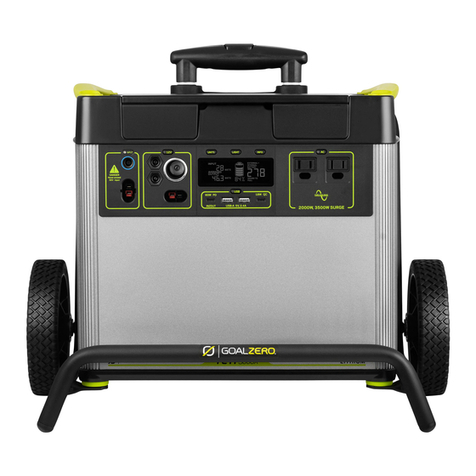
GOAL ZERO
GOAL ZERO YETI 3000 Lithium User manual
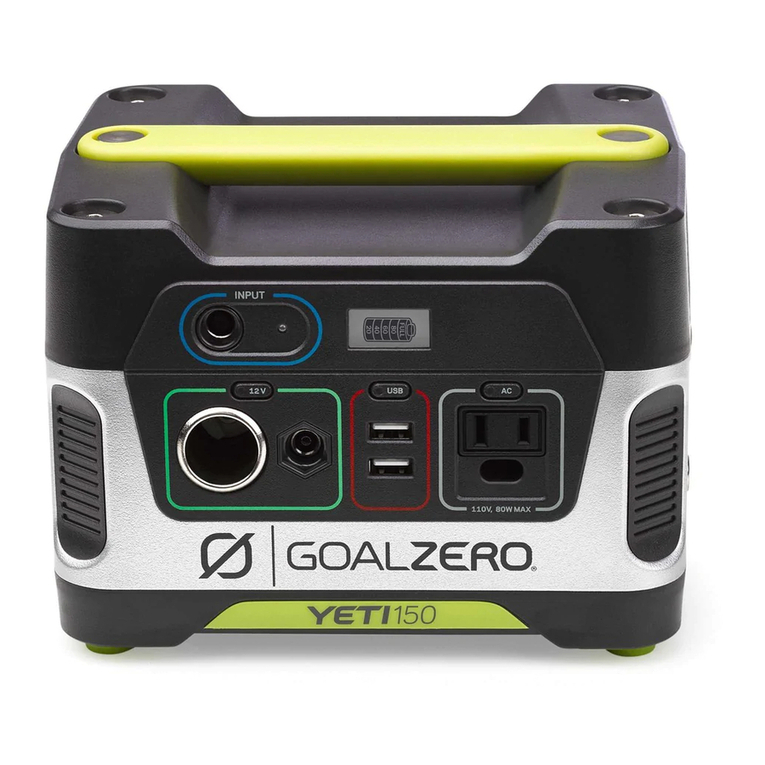
GOAL ZERO
GOAL ZERO Yeti 150 User manual
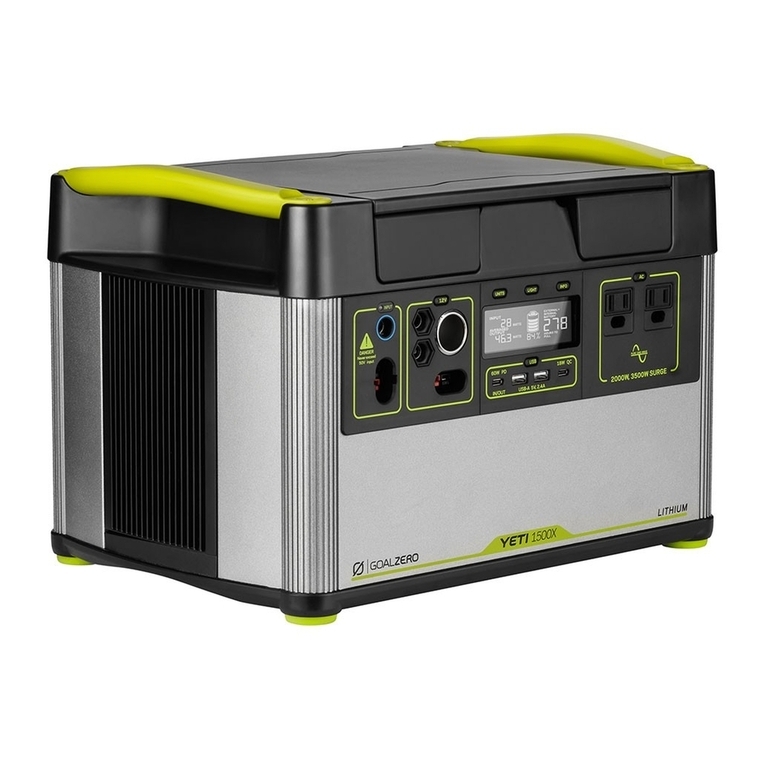
GOAL ZERO
GOAL ZERO YETI 1500X User manual

GOAL ZERO
GOAL ZERO Yeti 1250 User manual
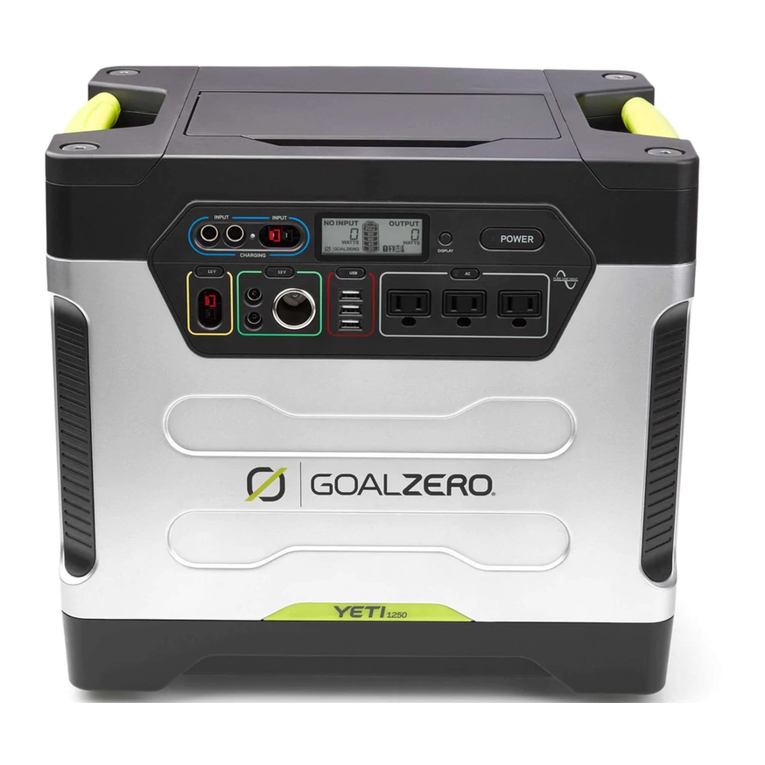
GOAL ZERO
GOAL ZERO Yeti 1250 User manual
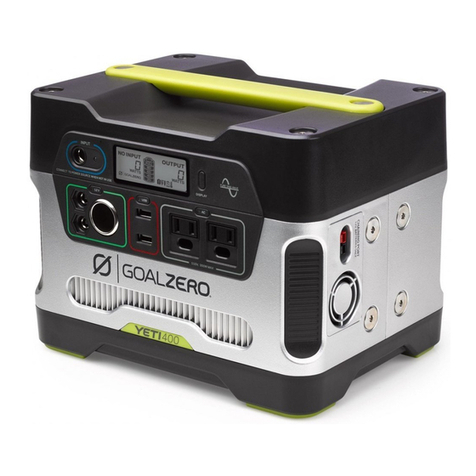
GOAL ZERO
GOAL ZERO Yeti 400 User manual

GOAL ZERO
GOAL ZERO Yeti 400 User manual
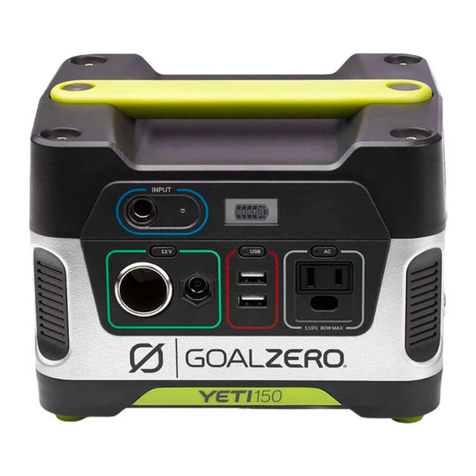
GOAL ZERO
GOAL ZERO Yeti 150 User manual

GOAL ZERO
GOAL ZERO Yeti 1250 User manual
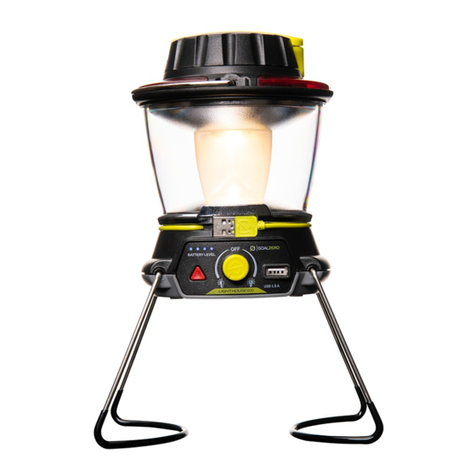
GOAL ZERO
GOAL ZERO Lighthouse 600 User manual


